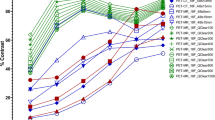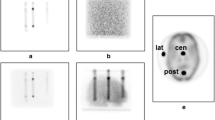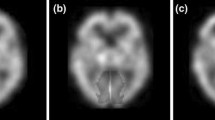Abstract
Iterative reconstruction techniques such as an ordered subsets-expectation maximization (OSEM) algorithm can easily incorporated various physical models of attenuation or scatter. We implemented OSEM reconstruction algorithm incorporating compensation for distance-dependent blurring due to the collimator in SPECT. The algorithm was examined by computer simulation to estimate the accuracy for brain perfusion study.Methods: The detector response was assumed to be a two-dimensional Gauss function and the width of the function varied linearly with the source-to-detector distance. The attenuation compensation (AC) was also included. To investigate the properties of the algorithm, we performed computer simulations with the point source and digital brain phantoms. In the point source phantom, the uniformity of FWHM for the radial, tangential and longitudinal directions was evaluated on the reconstruction image. As for the brain phantom, quantitative accuracy was estimated by comparing the reconstructed images with the true image by the mean square error (MSE) and the ratio of gray and white matter counts (G/W). Both noise free and noisy simulations were examined.Results: In the point source simulation, FWHM in radial, tangential and longitudinal directions were 14.7, 14.7 and 15.0 mm at the image center and were 15.9, 9.83 and 10.6 mm at a distance of 15 cm from the center by using FBP, respectively. On the other hand, they were 8.12, 8.12 and 7.83 mm at the image center, and were 7.45, 7.44 and 7.01mm at 15 cm from the center by OSEM with distance-dependent resolution compensation (DRC). An isotropic and stationary resolution was obtained at any location by OSEM with DRC. The spatial resolution was also improved about 6.5 mm by OSEM with DRC at the image center. In the brain phantom simulation, the blurring at the edge of the brain structure was eliminated by using OSEM with both DRC and AC. The G/W was 2.95 and 2.68 for noise free and noisy cases, respectively, when no compensation was performed. But the values for G/W without and with noise became 3.45 and 3.21 with AC only and were improved to 3.75 and 3.71 with both AC and DRC. The G/W approached the true value (4.00) by using OSEM with both AC and DRC even when there was statistical noise.Conclusion: In conclusion, OSEM reconstruction including the distance-dependent resolution compensation algorithm was reasonably successful in achieving isotropic and stationary resolution and improving the quantitative accuracy for brain perfusion SPECT.
Similar content being viewed by others
References
Lewitt RM, Edholm PR, Xia W. Fourier method for correction of depth-dependent collimator blurring.Proceeding of SPIE 1989; 1092: 232–243.
Zeng GL, Gullberg GT. Frequency domain implementation of the three-dimensional geometric point response correction in SPECT imaging.IEEE Trans Nucl Sci 1992; 39: 1444–1453.
van Elmbt L, Walrand S. Simultaneous correction of attenuation and distance-dependent resolution in SPECT: an analytical approach.Phys Med Biol 1993: 38: 1207–1217.
Glick S, Penney B, King M, Byrne CL. Noniterative compensation of photon attenuation and the distance-dependent detector response in SPECT imaging.IEEE Trans Med Imag 1994; 13: 363–374.
Xia W, Lewitt RM, Edholm PR. Fourier correction for spatially variant collimator blurring in SPECT.IEEE Trans Med Imag 1995; 14: 100–115.
Liang Z, Ye J, Li CJ, Harrington D. Quantitative cardiac SPECT in three dimensions: validation by experimental phantom studies.Phys Med Biol 1998; 43: 905–920.
Shinohara H, Yamamoto T, Sugimoto H, Hashimoto T, Takahashi M, Yokoi T. Scatter, attenuation and detector response correction of SPECT.Med Imag Tech 2000; 18: 24–32.
Ogawa K, Katsu H. Iterative correction method of shiftvariant blurring caused by collimator aperture in SPECT.Ann Nucl Med 1996; 10: 33–40.
Shepp LA, Vardi Y. Maximum likelihood reconstruction for emission tomography.IEEE Trans Med Imag 1982; 1: 113–122.
Hudson HM, Larkin RS. Accelerated image reconstruction using ordered subsets of projection data.IEEE Trans Med Imag 1994; 13: 601–609.
Murase K, Tanada S, Inoue T, Sugawara Y, Hamamoto K, Improvement of brain SPET using transmission data acquisition in a four-head SPECT scanner.Eur J Nucl Med 1993; 20: 32–38.
Matsuoka S, Shinohara H, Yamamoto S, Niio Y, Shima H, Yamada M, et al. Combined scatter and attenuation correction for Tl-201 myocardial perfusion SPECT using OS-EM algorithm.Nippon Acta Radiologica 1998; 58: 751–757.
Tsui BMW, Hu HB, Gilland DB, Gullberg GT. Implementation of simultaneous attenuation and detector response correction in SPECT.IEEE Trans Nucl Sci 1988; 35: 778–783.
Formiconi AR, Pupi A, Passeri A. Compensation of spatial system response in SPECT with conjugate gradient reconstruction technique.Phys Med Biol 1989; 34: 69–84.
Zeng GL, Gullberg GT, Tsui BMW, Terry JA. Threedimensional iterative reconstruction algorithms with attenuation and geometric point response correction.IEEE Trans Nucl Sci 1991; 38: 693–702.
Liang Z, Turkington TG, Gilland DR, Jaszczak RJ, Coleman RE. Simultaneous compensation for attenuation, scatter and detector response for SPECT reconstruction in three dimensions.Phys Med Biol 1992; 37: 587–603.
Tsui BMW, Zhao X, Frey EC, Gullberg GT. Comparison between ML-EM and WLS-CG algorithms for SPECT image reconstruction.IEEE Trans Ned Imag 1994; 13: 601–609.
Ju Z-W, Frey EC, Tsui BMW. Distributed 3-D iterative reconstruction for quantitative SPECT.IEEE Trans Nucl Sci 1995; 42: 1301–1309.
Pan T-S, Luo D-S, Kohli V, King MA. Influence of OSEM, elliptical orbits and background activity on SPECT 3D resolution recovery.Phys Med Biol 1997; 42: 2517–2529.
Pretorius PH, King MA, Pan T-S, de Vries DJ, Glick SJ, Byrne CL. Reducing the influence of the partial volume effect on SPECT activity quantitation with 3D modeling of spatial resolution in iterative reconstruction.Phys Med Biol 1998; 43: 407–420.
Kohli V, King MA, Glick SJ, Pan TS. Comparison of frequency-distance relationship and Gaussian-diffusionbased method of compensation for distance-dependent spatial resolution in SPECT imaging.Phys Med Biol 1998; 43: 1025–1037.
Fleming JS, Simpson DE. A technique for simulation of the point spread function of a gamma camera.Phys Med Biol 1994; 39: 1457–1473.
Kao C-M, Pan X. Non-iterative methods incorporating a priori source distribution and data information for suppression of image noise and artifacts in 3D SPECT.Phys Med Biol 2000; 45: 2801–2819.
Hutton BF, Lau YH. Application of distance-dependent resolution compensation and post-reconstruction filtering for myocardial SPECT.Phys Med Biol 1998; 43: 1679–1693.
Salamon G, Huang YP.Computed Tomography of the Brain. Berlin-Heidelberg-New York; Springer-Verlag, 1980.
Yokoi T, Shinohara H, Hashimoto T, Yamamoto T, Niio Y. Implementation and performance evaluation of iterative reconstruction algorithms in SPECT: a simulation study using EGS4. Proceeding of the Second International Workshop on EGS.KEK Proceedings 2000; 20: 224–234.
Ogawa K, Harata Y, Ichihara T, Kubo A, Hashimoto S. A practical method for position-dependent Compton-scatter correction in single-photon emission CT.IEEE Trans Med Imag 1991; 10: 408–412.
Ichihara T, Ogawa K, Motomura N, Kubo A, Hashimoto S. Compton scatter compensation using the triple-energy window method for Single-and dual-isotope SPECT.J Nucl Med 1993; 34: 2216–2221.
Hashimoto J, Ogawa K, Kubo A, Ichihara T, Motomura N, Takayama T, et al. Application of transmission scan-based attenuation compensation to scatter-corrected thallium-201 myocardial single-photon emission tomographic images.Eur J Nucl Med 1998; 25: 120–127.
Meikle SR, Hutton BF, Bailey DL. A transmission dependent method for scatter correction in SPECT.J Nucl Med 1994; 35: 360–367.
Narita Y, Eberl S, Iida H, Hutton BF, Braun F, Nakamura T, et al. Monte Carlo and experimental evaluation of accuracy and noise properties of two scatter correction methods for SPECT.Phys Med Biol 1996; 41: 2481–2496.
Iida H, Narita Y, Kado H, Kashikura A, Sugawara S, Shoji Y, et al. Effects of scatter and attenuation correction on quantitative assessment of regional cerebral blood flow with SPECT.J Nucl Med 1998; 39: 181–189.
Welch A, Gullberg G. Implementation of a model-based nonuniform scatter correction scheme for SPECT.IEEE Trans Med Imag 1997; MI-16: 717–726.
Beekman FJ, Kamphuis C, Frey EC. Scatter compensation methods in 3D iterative SPECT reconstruction: a simulation study.Phys Med Biol 1997; 42: 1619–1632.
Beekman FJ, den Harder JM, Viergever MA, van Rijk PP, SPECT scatter modeling in non-uniform attenuating objects.Phys Med Biol 1997; 42: 1133–1142.
Press WH, Teukolsky SA, Vetterling WT, Flannery BP.1993 Numerical Recipes in C. Japanese Edition (Tokyo; Gijutsu Hyoron Sha).
Yokoi T. Implementation of reconstruction program using maximum likelihood-expectation maximization (ML-EM) algorithm.Jpn J Nucl Med Tech [Kaku-Igaku gijutsu] 2000; 20: 331–340.
Maniawski PJ, Morgan HT, Wackers FJT. Orbit-related variation in spatial resolution as a source of artifactual defects in thallium-201 SPECT.J Nucl Med 1991; 32: 871–875.
Author information
Authors and Affiliations
Corresponding author
Rights and permissions
About this article
Cite this article
Yokei, T., Shinohara, H. & Onishi, H. Performance evaluation of OSEM reconstruction algorithm incorporating three-dimensional distance-dependent resolution compensation for brain SPECT: A simulation study. Ann Nucl Med 16, 11–18 (2002). https://doi.org/10.1007/BF02995286
Received:
Accepted:
Issue Date:
DOI: https://doi.org/10.1007/BF02995286




